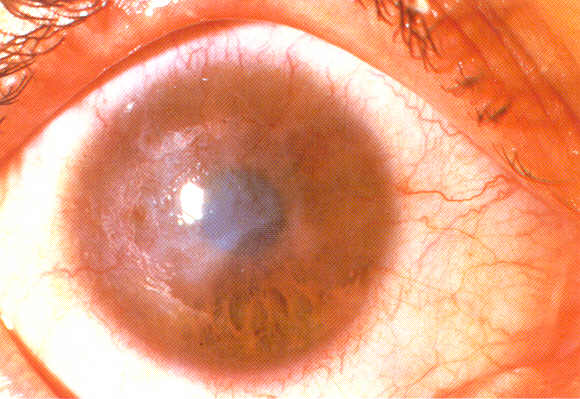
"News with equal focus on each person"
| 16 May 2006 | Archive | Subscribe for free by E-mail
or |
|
By Larry Baum An eye with trachoma
Source: WHO
The Chlamydia trachomatis bacterium causes sexually transmitted disease but can also infect the eye, where untreated infection (called trachoma) can cause blindness. As recently as 1985, 360 million people suffered from trachoma, and millions were blind due to the disease. It was the leading cause of blindness. Now for the good news and the bad news. Trachoma is easily preventable and treatable, and concerted public heath efforts over the last two decades have reduced the number of trachoma sufferers by almost 80%. But that still leaves 80 million infected and two million blind. The bacteria spread from person to person by hands or towels that touch the eyes or fluids from the eyes, or by flies that like to eat the fluid from runny eyes. One infection by the bacteria is not enough to cause lasting damage. But repeated infections that begin in childhood and that continue for years can permanently damage the eye, and with 60-90% of young children infected at any time in many parts of the world, this risk is high. Years of recurring infections scar the inside of the eyelid, causing the lid to curl in toward the surface of the eye and making the eyelashes rub against the eye with each blink, causing not only pain but also injury to the cornea, which ultimately causes blindness. Middle-aged women are particularly vulnerable, probably because they spend much more time caring for infected children than do men. Trachoma used to affect most of the world, but improved hygiene and other control measures have reduced its range to mostly the poorest regions. Now, trachoma causes 3% of all cases of blindness. In 1997, the World Health Organization (WHO) began a program to eliminate trachoma as a blinding disease. GET 2020 (Global Elimination of Trachoma) emphasizes a strategy called "SAFE", which stands for lid surgery for trichiasis (inturned eyelashes) (S), antibiotics to treat the community pool of infection (A), facial cleanliness (F), and environmental changes (E). The goal of GET 2020 is to eliminate blinding trachoma as a public health problem by 2020. Countries, charities, and companies contribute to trachoma elimination, including The Carter Center, Orbis, and Christian Blind Mission International. Lions Club International has focused its charity efforts on eye diseases such as trachoma. The drug company Pfizer has donated 37 million doses of the antibiotic azithromycin used as part of the SAFE strategy, and has promised to give 100 million more doses. Sources: New York Times, WHO |
The 2006 Bottom 10 ListBy Larry BaumNo, it's not David Letterman's list. It's the UN's "Ten Stories the World Should Hear More About." News stories often focus on certain issues while ignoring others that may be even more important. To try to draw attention to a handful of these relatively neglected items, the UN today issued its third annual list. There is no particular order of importance in the items. Here they are:
How was this story's length set? By Larry BaumResearchers studying mosquitoes in the wild discovered that most are naturally resistant to carrying the malaria parasite. In their April 28 article in the journal Science, the scientists reported that at least one gene, APL1, of Anopheles gambiae mosquitoes is needed to resist malaria infection. The authors propose the possibility of fighting malaria by killing all the non-resistant mosquitoes, for example, by spraying a fungus that preferentially kills infected insects. How was this story's length set? |
||
| How is Human News different? | Links | Contact Human News | |

This work is licensed under a Creative Commons Attribution 2.5 License.
Feel free to use anything here as long as you link to the article above or mention Human News.